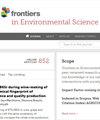爱尔兰一个养羊场地面道路和人行道表面材料中可用磷的空间分布
IF 3.3
3区 环境科学与生态学
Q2 ENVIRONMENTAL SCIENCES
引用次数: 0
摘要
当与水域发生连通时,农场路面径流是一种高风险污染源。这种径流中的营养物质主要是新鲜动物沉积物,但最近的奶牛场和肉牛场研究表明,可用磷(P)会在路面材料中累积,并随径流流失。目前的一个知识空白是研究低地绵羊养殖场未封闭路面和跑道(非维护)网络中的可用磷浓度。本研究的重点是爱尔兰东南部一个面积为 45 公顷、存栏 544 只羊的农场。2022 年 12 月,对 10 个地点及邻近田地进行了可用磷(即摩根磷)和辅助参数(如 pH 值、总磷和重金属)采样。第一个采样点位于集料路面上,其他九个采样点位于代表羊群使用的旧集料路面网络的履带上,但现在已被土壤和草覆盖。结果显示,路面和跑道表面材料的 pH 值存在明显差异。人行道的 pH 值与邻近草地农艺学最佳 pH 值 ∼6.2 附近的田地相似。所有采样地点的可利用磷浓度都很高,从 26.3 到 111.0 毫克/升(平均 62.8 毫克/升)不等,与奶牛场的空间分布相似,但高于之前研究的肉牛养殖场。牧场附近的道路和人行道上的 P 浓度最高。其他高浓度采样区位于远离牧场的人行道上(87.3 或 97.7 毫克 P L-1),羊群在人行道上被赶往牧场,停下来寻找阴凉处、大小便,但不在此吃草。相比之下,周围田地的平均可利用磷浓度为 8.4 毫克/升,范围为 2.7-15.9 毫克/升。两个取样区域结合在一起,形成了一个临界源区,在这里,高浓度的可利用钾源在降雨时被径流明显移动,排入一条露天排水沟,然后与当地的一条小溪相连。在径流进入明沟之前切断路径,是减少这两个地方养分流失的一种廉价而有效的方法。本文章由计算机程序翻译,如有差异,请以英文原文为准。
Spatial distribution of available phosphorus in surface road and trackway surface materials on a sheep farm in Ireland
Farm roadway runoff is a high-risk source of pollution when connectivity with waters occurs. Nutrients in this runoff are dominated by fresh animal deposits, but recent dairy and beef farm studies showed that available phosphorus (P) accumulates in roadway surface material and can be lost in runoff. A current knowledge gap is to examine available P concentrations in unsealed roadway and trackway (non-maintained) network of a lowland sheep farm. The present study focused on a 45 ha farm stocked with 544 sheep in south-east Ireland. Ten locations were sampled along with the adjacent fields for available P (i.e., Morgan’s P) and ancillary parameters (e.g., pH, total P and heavy metals) in December 2022. The first sampling location was on an aggregate roadway and the other nine were on trackways representing an older aggregate roadway network used by the flock but now covered with soil and grass. Results showed a distinct difference in surface material pH between roadway and trackway locations. Trackways had a pH that mimicked adjacent fields around the agronomic optimum for grassland of ∼6.2. All sampling locations had elevated available P concentrations, ranging from 26.3 to 111.0 mg L−1 (mean 62.8 mg L−1 ), similar to the spatial distribution for dairy farms but above those found at beef farms previously studied. The highest available P concentrations were found in roadway and trackway sections adjacent to the farmyard. Other elevated sampling areas were on trackways (87.3 or 97.7 mg P L−1 ) away from the farmyard where sheep are funnelled to pasture, stop to seek shade, urinate and defecate but do not graze. By contrast the average available P concentration for the surrounding fields was 8.4 mg L−1 with a range of 2.7–15.9 mg L−1 . Two sampling areas combine to create a critical source area where a high available P source becomes visibly mobilised as runoff during rainfall, discharges into an open drainage ditch, which is then connected to a local stream. Breaking the pathway before runoff enters the open ditch could be a cheap and effective way of mitigating nutrient losses at these two locations.
求助全文
通过发布文献求助,成功后即可免费获取论文全文。
去求助
来源期刊

Frontiers in Environmental Science
Environmental Science-General Environmental Science
CiteScore
4.50
自引率
8.70%
发文量
2276
审稿时长
12 weeks
期刊介绍:
Our natural world is experiencing a state of rapid change unprecedented in the presence of humans. The changes affect virtually all physical, chemical and biological systems on Earth. The interaction of these systems leads to tipping points, feedbacks and amplification of effects. In virtually all cases, the causes of environmental change can be traced to human activity through either direct interventions as a consequence of pollution, or through global warming from greenhouse case emissions. Well-formulated and internationally-relevant policies to mitigate the change, or adapt to the consequences, that will ensure our ability to thrive in the coming decades are badly needed. Without proper understanding of the processes involved, and deep understanding of the likely impacts of bad decisions or inaction, the security of food, water and energy is a risk. Left unchecked shortages of these basic commodities will lead to migration, global geopolitical tension and conflict. This represents the major challenge of our time. We are the first generation to appreciate the problem and we will be judged in future by our ability to determine and take the action necessary. Appropriate knowledge of the condition of our natural world, appreciation of the changes occurring, and predictions of how the future will develop are requisite to the definition and implementation of solutions.
Frontiers in Environmental Science publishes research at the cutting edge of knowledge of our natural world and its various intersections with society. It bridges between the identification and measurement of change, comprehension of the processes responsible, and the measures needed to reduce their impact. Its aim is to assist the formulation of policies, by offering sound scientific evidence on environmental science, that will lead to a more inhabitable and sustainable world for the generations to come.
 求助内容:
求助内容: 应助结果提醒方式:
应助结果提醒方式:


